Magic Roux Cubes
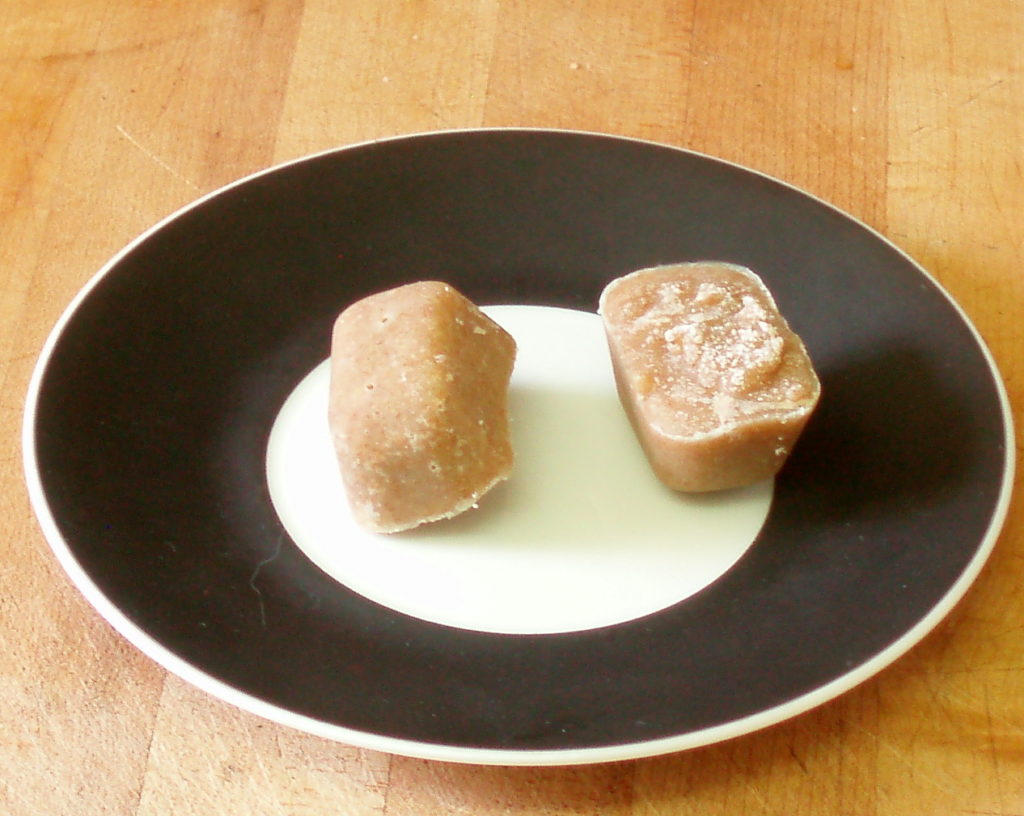 These cubes look pretty boring, don’t they? Plain little brown lumps… innocuous, uninteresting, uninspired… And yet, of all the Convenient Foods I use, these are the ones that changed my cooking the most. They allow me to make sauces, gravies, and thickened soups, quickly and easily, to pull random foods together into a delicious meal. And they open up for me a world of recipes in which the sauce is an ingredient – macaroni and cheese, croquettes, even souffles are easier if I’m not fussing about the base sauce.
These cubes look pretty boring, don’t they? Plain little brown lumps… innocuous, uninteresting, uninspired… And yet, of all the Convenient Foods I use, these are the ones that changed my cooking the most. They allow me to make sauces, gravies, and thickened soups, quickly and easily, to pull random foods together into a delicious meal. And they open up for me a world of recipes in which the sauce is an ingredient – macaroni and cheese, croquettes, even souffles are easier if I’m not fussing about the base sauce.
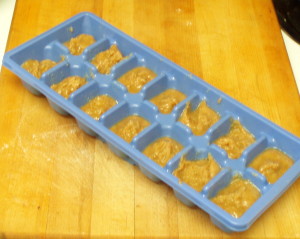 They are simply frozen premade roux. Frozen in an ice cube tray, in servings of roughly one tablespoon of flour, enough to make one cup of thin sauce. But I find the freezing itself, as well as preserving the roux, actually makes it easier to use.
They are simply frozen premade roux. Frozen in an ice cube tray, in servings of roughly one tablespoon of flour, enough to make one cup of thin sauce. But I find the freezing itself, as well as preserving the roux, actually makes it easier to use.
I’ve been making these for several years, now. I read something about making roux in advance, and keeping it in the refrigerator to use at will, as restaurant kitchens do. Much easier than stopping and making some every time you want to thicken a little gravy, or make a cream soup… I thought it sounded sensible. But we don’t really eat many thickened sauces. I usually just serve the broth or cooking liquid, and it would take too long to use it up. So I thought I’d try freezing it. And I found that this not only preserves it, up to several months, but it also makes it very easy to make a smooth sauce without fuss (or lumps.)
All right – first, making the roux. I’m using butter and whole wheat flour, here. The classic proportions are 1:1 – 1 tablespoon of each, to make a thin sauce with one cup of liquid, more for a thicker sauce. I found, though, that when I used equal amounts, the roux came out a bit greasy… I don’t need that much fat to 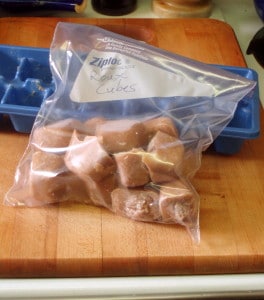 brown the flour, in the larger amounts. Also, I often add the cubes to stock or meat juices that already have some fat in them – which, again, can be greasy. So I use 3/4 cup of butter to one cup of flour. And I use whole wheat because that’s how I cook… white will work (though I, personally, think it tastes bland, since I’m used to whole grains.)
brown the flour, in the larger amounts. Also, I often add the cubes to stock or meat juices that already have some fat in them – which, again, can be greasy. So I use 3/4 cup of butter to one cup of flour. And I use whole wheat because that’s how I cook… white will work (though I, personally, think it tastes bland, since I’m used to whole grains.)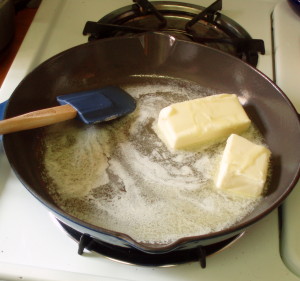
I make what is considered a blond roux – that is, I cook it long enough for the flour to be fully cooked, but not to brown it deeply. In classic French cooking, this is used for white sauce, chicken soup, other light foods. A brown roux is cooked longer, the color darkens, and the flavor becomes more assertive. And it loses thickening power – you need more for the same result. This is used for brown sauces – gravy, essentially. I’m not that classic – I just make the blond – but you can certainly brown it further if you think that will be useful for you. 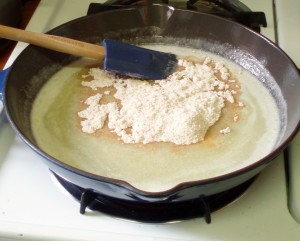 Also, this is *not* a Cajun roux, which is browned to a deep caramel color, and used more for flavoring than thickening. That will not work as well. It’s usually made these days with vegetable oil because of the higher smoke point – and vegetable oil doesn’t work in this method, as it does not solidify in the freezer. (Made with lard, in the traditional manner, it probably would – I have not tried it.)
Also, this is *not* a Cajun roux, which is browned to a deep caramel color, and used more for flavoring than thickening. That will not work as well. It’s usually made these days with vegetable oil because of the higher smoke point – and vegetable oil doesn’t work in this method, as it does not solidify in the freezer. (Made with lard, in the traditional manner, it probably would – I have not tried it.)
Melt 3/4 cup – that is, a stick and a half, or 12 tablespoons – of butter in a heavy pan, over low heat. Even heat matters, here, so use the best pan you have – cast iron, multi-ply, not something thin and light, if you can help it. If your pan does have hot spots, keep the light very low, and watch it carefully – you want to brown without burning.
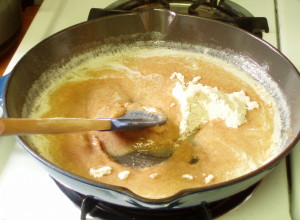 Then, I find a silicone spatula invaluable. When I was a kid, my mother had a real rubber one that she used for sauces, though she had to be careful of high heat, but when I set up housekeeping, all you could get were plastic, which didn’t stand up to any heat. I was thrilled when the silicone came out! What I do is sort of smear the flour gently into the melted butter… Sprinkle in part of the flour, then work it slowly in with the flat of the spatula, blending it gradually, as you add more flour.
Then, I find a silicone spatula invaluable. When I was a kid, my mother had a real rubber one that she used for sauces, though she had to be careful of high heat, but when I set up housekeeping, all you could get were plastic, which didn’t stand up to any heat. I was thrilled when the silicone came out! What I do is sort of smear the flour gently into the melted butter… Sprinkle in part of the flour, then work it slowly in with the flat of the spatula, blending it gradually, as you add more flour.
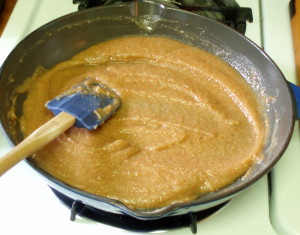 When you finish blending it all in, continue over low heat, stirring and scraping the pan with the spatula. This does take longer than just a tablespoon, but it’s worth it in time saved over the long run. The flour will darken towards a gold color – though that would be more obvious with white flour. Using low heat and an enameled cast iron pan, I gave it 15 minutes, here – I would say 10 is the least you want. The goal is to have all the flour fully cooked, so there is no raw flavor.
When you finish blending it all in, continue over low heat, stirring and scraping the pan with the spatula. This does take longer than just a tablespoon, but it’s worth it in time saved over the long run. The flour will darken towards a gold color – though that would be more obvious with white flour. Using low heat and an enameled cast iron pan, I gave it 15 minutes, here – I would say 10 is the least you want. The goal is to have all the flour fully cooked, so there is no raw flavor.
At the end of that time, turn off the heat, stir a few more times, then let it cool. Now – for the cubes… To be precise, you would want 16 cubes, one for each tablespoon of flour. I’m not that precise… The ice cube tray I use for such things happens to make 14 cubes. What I usually do is carefully divide almost all of it evenly between them – then, instead of scraping the pan, use the roux left in it for some sauce for the next meal. I figure each cube probably has just a titch more than the tablespoon of flour – but cooking is not that exact a science… a few grams here and there really don’t matter. What you do will depend on your own ice cube tray and comfort level. Then I freeze the tray. When it is frozen, I pop the cubes out into a labeled zip freezer bag, and put it back in the freezer.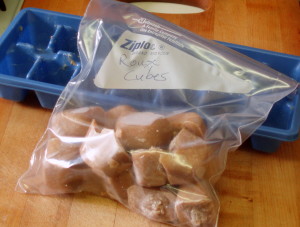
I then, over time, use these for white sauce, and cream soup, and gravy, and cheese sauce, and to thicken soups, and use in a wide variety of recipes, that are now easy and fast. (Nothing like a 5 minute sauce to pull leftovers together…) You can use all or part olive oil if you want something without dairy or need to limit the use of butter – I’ve done that with success. I haven’t tried it with other fats – but want to… Haven’t yet tried other flours, either, though I will. I don’t know what the equivalent amounts are – I understand that can vary for some things. I think the flavors might be interesting, though, as well as it being helpful for someone who doesn’t eat wheat.
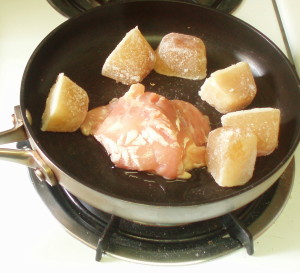 Just as an example, I threw together a chicken gravy for lunch. I took a frozen piece of boneless chicken from my freezer stash, put it in a small pan with cubes of homemade chicken stock, added some seasoning, covered it, and cooked until the chicken was done. Then I removed the chicken to a plate, added one roux cube, and heated it, stirring frequently (not constantly.)
Just as an example, I threw together a chicken gravy for lunch. I took a frozen piece of boneless chicken from my freezer stash, put it in a small pan with cubes of homemade chicken stock, added some seasoning, covered it, and cooked until the chicken was done. Then I removed the chicken to a plate, added one roux cube, and heated it, stirring frequently (not constantly.)
The great secret about these – the real trick – is that, as the cube melts, small amounts of roux come off the sides and blend into the liquid. They do not lump. I do stir it, but not constantly, not with the care I need if I’m using fresh roux. I don’t need the silicone spatula, or a whisk, or anything but a plain spatula or spoon. I keep the liquid at a low simmer, until the cube(s) melt, then another few minutes as the sauce thickens. (You can see in the pan that there is some chicken fat from the meat – the reason I use less butter in the cubes.)
 So – I stirred every minute or two, while I heated rice. I ate rice, because I had rice – but this would be great over biscuits, or a microwaved potato, or even just bread… Whatever you like and can put together easily. (Serving the family, an easy no fuss gravy makes fresh biscuits or mashed potatoes more doable.) I returned the meat to the pan for a minute to warm it, then served myself.
So – I stirred every minute or two, while I heated rice. I ate rice, because I had rice – but this would be great over biscuits, or a microwaved potato, or even just bread… Whatever you like and can put together easily. (Serving the family, an easy no fuss gravy makes fresh biscuits or mashed potatoes more doable.) I returned the meat to the pan for a minute to warm it, then served myself.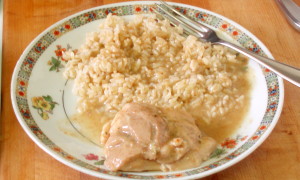
And, suddenly, chicken gravy for one serving is not insane.
Edited to Add – My newest Gluten Free Roux Cube recipe!
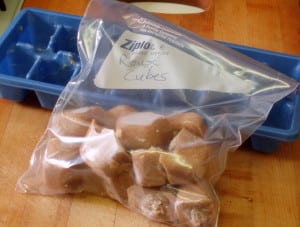
Magic Roux Cubes
Ingredients
- 3/4 c butter
- 1 c whole wheat flour
Instructions
- Melt butter in a heavy pan over low heat.
- Gradually stir in the flour, mixing until completely smooth. (A silicone spatula is the best tool for this job.)
- Heat the mixture, over low heat, stirring, for 10 - 15 minutes, until the flour is completely cooked and very slightly browned. Let cool.
- Pour into an ice cube tray, making 14-16 cubes. Freeze.
- To use, stir into simmering liquid, until it thickens as desired. 1 cube for a thin sauce, 2 for a thicker one, 3 for a very thick one, used as a base for other foods.

That’s really clever, great idea 🙂 #recipeoftheweek
Thank you!
This is a wonderful shortcut method and I had no idea one could do this with roux. I’ve seen it done with stock before, but not with roux. Very cool…
Thanks. It makes it easy to avoid the canned soups and jarred sauces! And I’ve never seen anyone else do it, either – though it’s hard to believe no one ever thought of it before I did…
What a great idea! This is something that I will be doing for sure! Thank you for sharing #MadeWithLuv
Great idea! A real time saver. Rouxs are my nemesis. They either work perfectly or go horribly wrong 🙂
Thank you!
It saves time – and it really makes it easier. I was surprised by that aspect – I fully expected to keep fighting lumps, just save the initial time – and this was so simple. I have to share it!
I make my own Japanese curry roux and I have never attempting to prepare this. Thanks for sharing with 4 seasons blog hop. Cheers and have a nice day.
Cool!
That’s something I’ve considered – I have used the commercial curry roux. May I ask what fat/oil you use?
For the cubes to work (I learned…) you need a fat that solidifies in the freezer – butter, olive oil, etc. Canola oil didn’t work. I have wondered what my other options might be.
What a great idea that I will be using! Thanks so much for sharing your awesome post with Full Plate Thursday and hope you have a great week!
Come Back Soon!
Miz Helen
I made a bunch of these yesterday — other than a slight difficulty getting them out of the ice cube tray, they work like a total charm.
Excellent idea!
Thanks for letting me know!
This is such a great idea! Can this be made with Ghee? What about making it gluten free?
Thank you! I don’t know about ghee – if you freeze it, does it solidify? Because it must do that to make the cubes. Olive oil works, and coconut oil, as do lard or chicken fat, but I have not tried ghee. And at the very bottom of the post, you’ll find a link to a gluten free version! The recipe did need a little tweaking, so check it out, and enjoy!